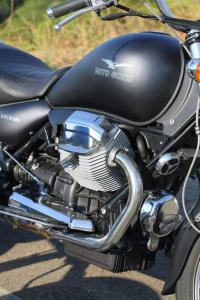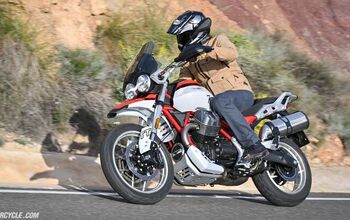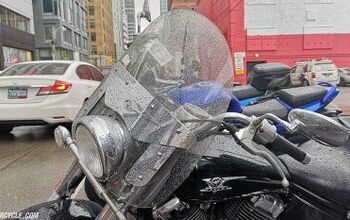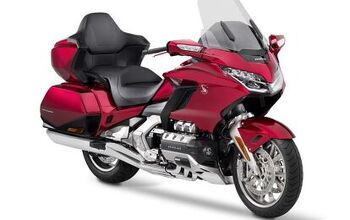2011 Moto Guzzi California Black Eagle Review - Motorcycle.com
Fast on the heels of the Moto Guzzi Norge review comes another model of Italian eccentricity, the Moto Guzzi California Black Eagle. Equipped with buckhorn bars and floorboards, it’s certainly no sportbike, but it’d take a crowbar and sledgehammer to shoehorn this model into any standardized cruiser category.
Cylinders jutting skyward from the sides of the bike, the Black Eagle is powered by an incorrectly mounted (in the traditional cruiser sense) V-Twin. The air-cooled, two-valves-per-cylinder, 1064cc engine is the iconic centerpiece of the Black Eagle and unarguably proclaims an individualism unto itself.
It produces a respectable 70 horsepower, which is very high for a cruiser engine of less than 1100cc. On the flip side is a modest 60 ft.-lb of torque produced relatively high in the rev range (5200 rpm). This uncharacteristic-for-a-cruiser powerplant exhibits a strange power curve against competitive cruiser models that exhibit much greater low-end vigor.
Rolling from a stop requires more clutch slippage than other cruisers, and a narrow engagement zone at the end of the lever travel requires some finesse. But the engine’s relatively lofty powerband makes first gear very usable in city traffic. Powerplant points are deducted for its old-school fuel-injection system that requires actuating a fuel-enrichener lever during cold starts. Fuel mapping seems to be on the lean side, as large throttle openings result in a slight lag in response.
Guzzi compensates the Black Eagle’s lack of torquey thrust with a surprising amount of lean angle. In fact, we’d venture to say that the Black Eagle exhibits more lean angle than any cruiser we’ve ever ridden. Unlike its lowered, feet-forward cruiser brethren that excel in dragging every hard-part possible at painfully mundane speeds, the Black Eagle begs to be cornered.
This cornering prowess isn’t without drawbacks. To achieve the Black Eagle’s abnormally high ground clearance Moto Guzzi attached the floorboards in an elevated position above the tarmac. Combined with the positioning of the floorboards — neither directly below nor stretched in front of the rider — this forces the rider’s knees to rise above the fuel tank. For riders of average height this peculiar arrangement takes some getting accustomed to, while for taller riders the discomfort is exacerbated. The ergonomic package is reminiscent of an over-sized Honda Rebel.
Making matters worse are the buckhorn handlebars. The comfortably positioned bars trap a taller rider’s knees against the fuel tank during tight maneuvers. This design oversight is not only a parking-lot-speed performance deficiency but also a safety issue. The foible can be resolved by remembering to swing the impeding knee out of the way before making a tight turn or by raising the bars by rolling them forward in the bar clamp risers. Or replacing them altogether. This design deficiency for long-legged riders should be addressed, but maybe it’s not an issue for generally shorter Italian riders.
Short of these aforementioned faults, the Black Eagle handles with aplomb for a couple of reasons. The yawning distance between handgrips provide uber amounts of leverage. And adding to the transitioning ease is the Black Eagle’s comparatively feathery sub-600-pound wet weight and a relatively stubby 61.4-inch wheelbase.
With access to both the Guzzi Black Eagle and a 2012 Triumph Thunderbird for a couple weeks, I found myself gravitating back to the Black Eagle after spending time on the Triumph. The big-digit torque figures bursting from the T-Bird’s 1597cc vertical Twin is head-jerking good fun, but at 746 pounds full of fluids I simply tired of holding the beast up at stoplights and dragging pegs at walking speeds around corners. The Black Eagle isn’t exhilarating in the torque department, but I prefer its lighter, more maneuverable mannerisms.
When testing the Moto Guzzi Norge, noticeable was the attention given to the bike’s fit and finish. Sadly, that trend doesn’t follow to the Black Eagle. The mechanism attaching the wide, comfortable one-piece seat doesn’t fasten securely, the rubber sidestand grommet vibrated loose, and internal rust was eating away on the outside of one muffler.
“Guzzi’s chrome-plating process seems to have remained unchanged since the California’s introduction in 1971,” remarks Pete.
The proximity of the heel/toe shifter to the left floorboard is prohibitively close and does not allow a booted toe beneath the shifter, forcing a Black Eagle owner to develop a delicate touch with the heel portion of the shifter in order to find neutral and upshift.
On the opposite side of the bike the high position of the floorboard doesn’t allow an acceptable range of motion in one’s ankle for proficient manipulation of the brake pedal. To overcome this Guzzi added a small node meant to provide the needed support and angle of a foot. However, in order to utilize the node, a rider must remove his foot from the floorboard and reposition it atop the node to properly work the brake.
“The rear brake is odd in that you need to place your heel onto a snubby peg to better modulate the brake pressure,” says Troy. “Otherwise you’ll either brake too hard or not enough.”
The Black Eagle doesn’t boast ABS, but it does feature linked braking. Engaging the rear brake pedal sends fluid pressure to both the front and rear Brembo calipers, which none of the MO testers appreciated. “The Brembo brakes seem sufficiently powerful enough to reel in the California,” says Pete, “but I could do without the linked rear to front brakes. Far too much front-end dive when applying a heavy dose of rear brake.”
For a cruiser, both the front brake and clutch levers are uncharacteristically narrow and feel relatively wimpy. Wider, more comfortable levers would be appreciated.
A steering damper is a component not often found as standard equipment on cruiser motorcycles, but the Black Eagle comes equipped with an Italian-made TT Suspension damper which keeps the Eagle’s front end stable at higher speeds.
Featuring compression and rebound adjustments up front and rear preload and rebound adjustments, the Eagle is more liberal with its suspension fine-tuning than most cruisers. Easy-to-use dials on top of each fork leg control the settings, with one fork leg handling compression and the other controlling rebound. Optimum rebound control was achieved by a setting just two clicks off max. Preload on the rear shock is the common ramp-style adjustment, while rebound is easily controlled by dials on the tops of each shock.
The matte black fuel tank holds five gallons of petrol which is good for upwards of 180 miles between fuel stops, according to the 36-mpg average the Black Eagle was exhibiting while in our possession.
In addition to its tank, the Aquila Nera (Italiano for Black Eagle) features matte-black fenders and side panels, which, in addition to its steering damper, set it apart from the standard Guzzi California model. The dull black paint scheme does an excellent job of emphasizing the Eagle’s metal components and engine.
In the subjectively stylized world of cruisers the Black Eagle held its own ground, garnering attention from civilians and motorcyclists alike. For the most part we’d agree with them both, but a critical eye is going to fault the Black Eagle for losing sight of flowing lines toward the rear of the motorcycle. In relation to the rear wheel, the rear fender is in another zip code, fixed high and well beyond the travel of the rear wheel, leaving an unsightly gap.
The Eagle’s finish quality is a bit lacking on a few components. The plasti-chrome instrument brightwork and turnsignals belie their humble origins, and the sloppy welds on the passenger grab rail are unpleasant. We also didn’t like its ultra-long sidestand that is extremely awkward to deploy, and retracting it is accompanied by a loud clang as two springs slam it to its stops.
Guzzi can only claim “character” when explaining away deficiencies in their motorcycles. Some of us find its weirdness can be endearing in a strange way, but Pete was more disappointed than the rest of us.
“I can see why some folks might find the Black Eagle a neat ride, and if the VIN plate had an early to mid-’70s year stamped on it I wouldn’t hold anything against this Guzzi. But too many things, practical things, on this motorcycle are in need of update, and no amount of quaintness can compensate to keep me interested.”
However, Editor Duke saw the Guzzi’s individuality in a different light. “Once you get over how weird it is, it begins to charm you. There’s nothing else quite like it,” he says.
Related Reading
2011 Moto Guzzi Norge 1200 GT 8V Review
Limited Edition 2012 Moto Guzzi California 90 Unveiled
Moto Guzzi California, Scrambler Prototypes
2011 Moto Guzzi Norge V7 Racer Announced
2009 Moto Guzzi V7 Cafe Classic Review
2008 Moto Guzzi Griso 8V
More by Tom Roderick



































Comments
Join the conversation